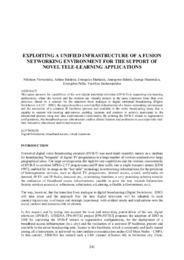Exploiting a unified infrastructure of a fusion Networking environment for the support of Novel tele-learning applications
Abstract
This paper presents the capabilities of the new digital terrestrial television (DVB-T) in supporting tele-learning
applications, where the lecturer and the students are virtually present in the same classroom from their own
premises. Based on a concept for the transition from analogue to digital terrestrial broadcasting (Digital
Switchover in UHF – DSO), the paper describes a novel unified infrastructure of a fusion networking environment
and the realisation of a common IP backbone (present and available in the entire broadcasting area), that is
capable to support tele-learning applications enabling lecturers and students to actively participate in the
educational process using real time interventions (video/audio). By utilising the DVB-T stream in regenerative
configurations, this broadband access infrastructure enables distant learners and professors to access/provide realtime
interactive educational audiovisual material.
